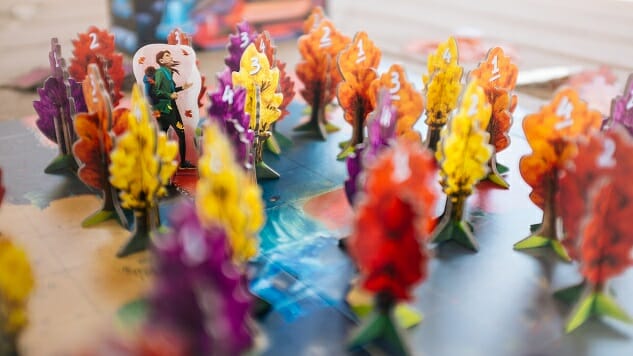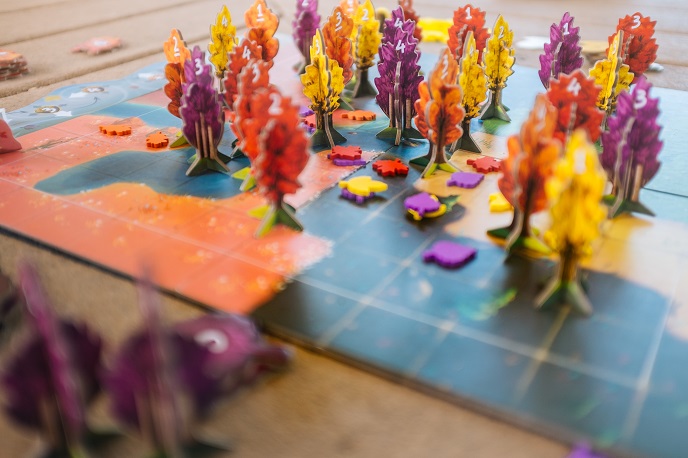
Bosk is the latest game from one of the co-designers of Sagrada, among my favorite games of 2017 (and recently expanded with three new titles), taking on a theme of growing trees and falling leaves where players aim for area control in two distinct phases. It’s a beautiful game with one of the best storage solutions I’ve come across, but the game play itself just doesn’t work for me; it plays slowly, and planning for the second and more important phase of the game can be too inconsequential for a strategy game.
In Bosk, two to four players each get a specific color of tree for the game, taking eight trees (3D cardboard pieces, as in Photosynthesis), 42 handsome wooden leaf tokens, eight cardboard leaf tokens, and one squirrel. The game’s phases correspond to the four seasons of the year, so you plant trees, then score them, then scatter leaves according to the shifting winds, and score those in a different way.
The spring planting phase is fairly simple. Players will go around the table and place all eight of their trees, which are numbered from one to four (two of each), on the intersections of gridlines around the board, with different board sizes for each number of players. After every player has placed all eight of their trees, the gridlines are scored in both directions. Add up the face values of each player’s trees on each gridline, awarding two points to the player who had the most total value on a line and one point to the player with the second-most. If you’re alone on a gridline, you get all three points. Thus the scoring for this first part, which counts as summer—tourists come and walk through the woods, along the gridlines, although in typical Keith-overthinking-the-theme fashion I kept picturing the hikers colliding with the trees—is modest, and it’s unlikely any player will rack up much of a lead.
The meat of the game comes in the fall, when players will scatter leaves from their eight trees to try to control squares in the eight distinct areas of the board. The player with the lowest score after summer gets to choose where the wind direction board sits for the remainder of the game; the wind will rotate through all four directions twice as players get to scatter leaves from all eight of their trees. On your turn, you pick one of your trees and one of your cardboard leaf tokens, which show numbers from two through eight. You then scatter that many leaves downwind from the tree you’ve chosen, with the goal of covering more squares in each area of the board than your opponents. Placing a wooden leaf on any empty square is free, but you can also place your leaf on top of someone else’s leaf token, paying (discarding) one leaf from your hand for each leaf in the pile you’re covering. That means the higher-value cardboard leaves are more useful later in the autumn phase, because they give you the power to cover other players’ piles and seize control of specific squares, creating a lot of back-and-forth battles for control of certain areas.
The squirrel also appears in the autumn as a sort of trump card. On one of your eight turns, you’ll still pick a tree, but this time you won’t scatter leaves, instead playing the squirrel somewhere downwind of your tree, covering any pile of any size for no cost with your squirrel. The squirrel can’t be topped, literally or figuratively, so you gain control of that square permanently. It’s powerful, but you also spend one of your eight autumn turns to place the squirrel (and no leaves).

The winter phase scores control of each of the eight areas on the board by counting each player’s leaves, only looking at the leaves on top of piles, in the squares of each area. You get five points for having the most squares in an area, three for second-most, and eight if you’re alone in an area. Two players tied for the most squares in an area split the eight points evenly; two or more players tied for second get a point each. This is, as they say, the big money round, and you can surge from worst to first—which did happen in the one four-player game I played, where all four players ended up separated by just two points in the end.
The core concept here is great: one board, two separate ways to score, which work in concert but are dissimilar enough that you can’t dominate both phases with one strategy. Both gameplay and the components have some significant problems, unfortunately. We found turns themselves to be slow in both phases, because you have to do a lot of mental arithmetic to guess at the best move, with the issue growing exponentially with the number of players. With just two players, you’re rarely on top of each other, and you don’t have to fight for control of any gridlines in the spring, but with four, the board fills up quickly, so figuring out where to play is … not difficult, but arduous. The leaf-scattering in autumn is even slower because of the huge decision tree (pun thoroughly intended) involved in choosing which tree to use and then examining all of the potential paths of leaves to scatter from it.
The pieces themselves are also a problem. Trying to work around the trees standing on the board to place your leaves in the autumn phase results in a lot of inadvertent clearcutting, because the trees was so easy to knock over. (I even had trouble punching many of them out of the cardboard sheets without damaging the top halves of the trees.) Smaller, less appealing plastic trees might have helped. The wooden leaf tokens are visually attractive but so smooth that everyone I played with would knock leaves off of other leaves, sometimes scattering whole piles. The art on the boards showing the different areas to control doesn’t line up well enough with the gridlines, so that some squares appear to belong to two areas (they don’t), and on one side one of the areas is split into two noncontiguous regions. We also found that the red and orange trees/leaves are too close in color and we had some trouble distinguishing them on the board.
The storage solution for Bosk is great—there are four cardboard inserts that can hold all the parts for one player each, and they perfectly fill the inside of the box, so setup and cleanup are simple. And it really does look great on the board—the wooden leaves are cute and the colors are bright—aside from the trouble we had keeping pieces in place. There are good ideas under the surface in Bosk, but in practice it will just leaf you wanting more.
Keith Law is a senior baseball writer for ESPN.com and an analyst on ESPN’s Baseball Tonight. You can read his baseball content at search.espn.go.com/keith-law and his personal blog the dish, covering games, literature, and more, at meadowparty.com/blog.